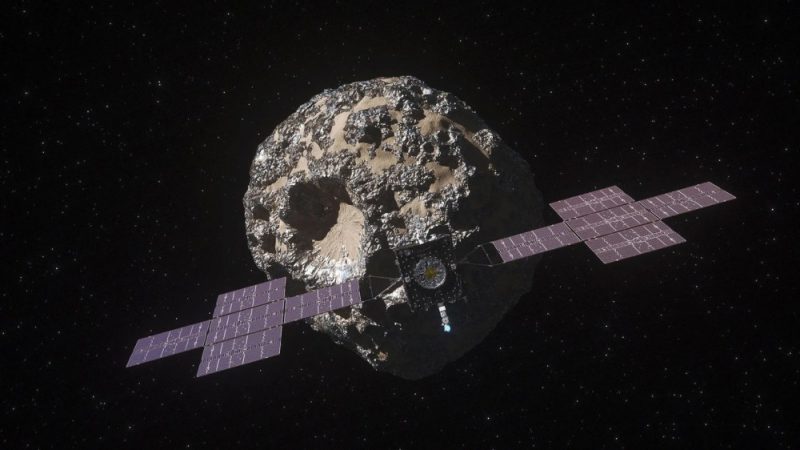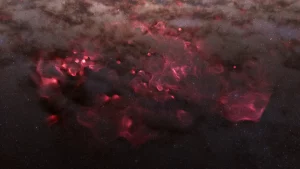In the race for space metals, companies hope to cash in

This article was originally featured on Undark.
In April 2023, a satellite the size of a microwave launched to space. Its goal: to get ready to mine asteroids. While the mission, courtesy of a company called AstroForge, ran into problems, it’s part of a new wave of would-be asteroid miners hoping to cash in on cosmic resources.
Potential applications of space-mined material abound: Asteroids contain metals like platinum and cobalt, which are used in electronics and electric vehicle batteries, respectively. Although there’s plenty of these materials on Earth, they can be more concentrated on asteroids than mountainsides, making them easier to scrape out. And scraping in space, advocates say, could cut down on the damaging impacts that mining has on this planet. Space-resource advocates also want to explore the potential of other substances. What if space ice could be used for spacecraft and rocket propellant? Space dirt for housing structures for astronauts and radiation shielding?
Previous companies have rocketed toward similar goals before but went bust about a half decade ago. In the years since that first cohort left the stage, though, “the field has exploded in interest,” said Angel Abbud-Madrid, director of the Center for Space Resources at the Colorado School of Mines.
A lot of the attention has focused on the moon, since nations plan to set up outposts there and will need supplies. NASA, for instance, has ambitions to build astronaut base camps within the next decade. China, meanwhile, hopes to found an international lunar research station.
Still, the pull of space rocks remains powerful and the new crop of companies hopeful. The economic picture has improved with the cost of rocket launches decreasing, as has the regulatory environment, with countries creating laws specifically allowing space mining. But only time will tell if this decade’s prospectors will cash in where others have drilled into the red or be buried by their business plans.
An asteroid-mining company needs one major ingredient to get started: optimism. A hope that they could start a new industry, one not of this world. “Not a lot of humans are built to work like that,” said Matt Gialich, co-founder and CEO of AstroForge. Since the company’s April 2023 demo mission, it has yet to come close to mining anything.
What he and colleagues hope to extract, though, are platinum-group metals, some of which are used in devices like catalytic converters, which reduce gas emissions. Substances like platinum and iridium, meanwhile, are used in electronics. There are also opportunities in green technology, and new pushes to produce platinum-based batteries with better storage that could end up in electric vehicles and energy storage systems.
To further the company’s goals, AstroForge’s initial mission was loaded with simulated asteroid material and a refinery system designed to extract platinum from the simulant, to show that metal-processing could happen in space.
“The field has exploded in interest.”
Things didn’t go exactly as planned. After the small craft got to orbit, it was hard to identify and communicate with among the dozens of other newly launched satellites. The solar panels, which provide the spacecraft with power, wouldn’t deploy at first. And the satellite was initially beset with a wobble that prevented communication. They have not been able to do the simulated extraction.
The company will soon embark on a second mission, with a different goal: to slingshot to an asteroid and take a picture—a surveying project which may help the company understand which valuable materials exist on a particular asteroid.
Another company, called TransAstra, is selling a telescope and software designed to detect objects like asteroids moving through the sky; Chinese corporation Origin Space has an asteroid-observing satellite in orbit around Earth, and is testing out its mining-relevant technology there. Meanwhile, Colorado company Karman+ plans to go straight to an asteroid in 2026 and test out excavation equipment.
To achieve the ultimate goal of pulling metals from space rocks, TransAstra, Karman+, and AstroForge have received a combined tens of millions of dollars in venture-capital funding to date.
Another company with similar aims, simply called Asteroid Mining Corporation Ltd., doesn’t want to rely much on outside investment in the long term. Such reliance, in fact, helped sink earlier companies. Instead, founder and CEO Mitch Hunter-Scullion is focusing his company’s early work on terrestrial applications that pay up immediately so he can fund future work in the broader universe. In 2021, the company partnered with Tohoku University Space Robotics Laboratory, based in Japan, to work on space robots.
Together, they have built a six-legged robot called the Space Capable Asteroid Robotic Explorer, or SCAR-E. Designed to operate in microgravity, it can crawl around a rugged surface and take data on, and samples of, what’s there. In 2026, the company plans to do a demonstration mission analyzing soil on the Moon.
For now, though, SCAR-E will stay on Earth and inspect ship hulls. According to one market research platform, this is a nearly $13 billion dollar market globally—as compared to the asteroid-mining market, currently $0, as no one has yet mined an asteroid.
Such grounded work may give the company a revenue stream before, and during, their time in space. “I think every asteroid-mining company has this realization that money runs out, investors get tired, and you have to do something,” said Hunter-Scullion.
“My opinion is that unless you’ve built something which makes sense on Earth,” he added, “you’re never going to be able to mine an asteroid.”
Ian Lange sees sideways applications like ship-inspections as the “gin” of space mining: Lots of distilleries want to make whiskey. But making whiskey requires years of maturing alcohol in a cask. “You can make gin right now,” said Lange, an economist at the Colorado School of Mines. The gin can float a company until their whiskey’s ripe.
AstroForge is betting that asteroid mining will happen soon enough that it doesn’t need gin.
Some of the economics are, in fact, better than they were in the 2010s. Rockets are significantly cheaper than when the prior companies started (and then stopped), for instance. But other considerations are more complicated. For one, said Lange, there’s no shortage of terrestrial resources. “It’s not that we don’t have lithium around,” he said, as an example. “The problem is that for a number of reasons, we’re not allowing ourselves to take them out of the ground.” Often, those reasons involve environmental concerns.
For some, extracting materials from space offers a way to reduce the burden on Earth’s resources. That consideration is especially prevalent when it comes to the extraction required for clean energy technologies, like hydrogen fuel production, which uses iridium, and hydrogen fuel cell cars, which require platinum. Certain metals—like nickel, cobalt, and iron—are also more concentrated in asteroids since, unlike Earth’s richest deposits, they haven’t been tapped yet.
“The problem is that for a number of reasons, we’re not allowing ourselves to take them out of the ground.”
But space mining isn’t without its own environmental impacts: Rocket launches, for instance, contribute greenhouse gases to the atmosphere, something Lange’s research notes. Extraction on space rocks would generate waste and debris, which would float out into the vacuum of space.
To combat such concerns, researchers suggested in 2019 that much of the solar system should be set aside as “wilderness,” like protected land on Earth. Allowing exploitation like mining on only one-eighth of cosmic resources, they wrote, could prevent the kinds of impacts that overzealous extraction has wrought at home. In 2021, researchers at the University of New South Wales in Australia published a proposed environmental impact framework to assess how damaging a given space-mining project would be, through factors like how much dust it would stir up.
But the kind of public outcry that accompanies endeavors like deep-sea mining isn’t likely to happen for asteroids: A 2022 study found that the public is largely in favor of asteroid mining, a finding that held regardless of people’s preconceived ideas about ecological fragility or their political ideology.
“People were much more supportive of mining asteroids than other forms of frontier mining like mining the ocean floor, mining Antarctica, and mining the Alaskan tundra,” Matthew Hornsey, lead author of the paper and a professor at the University of Queensland, wrote in an email to Undark. “They didn’t raise the same ethical objections that they did to other forms of mining, and they reported little anxiety about it.” Even those who typically would object to mining on environmental grounds felt that way, Hornsey says, likely because they saw the trade-off: Scar the Earth or scrape an asteroid.
The same, though, was not true of the moon, where respondents disapproved of mining more—sometimes more than they did ecologically sensitive parts of Earth. “The moon is visible, beautiful, and associated with purity and spirituality,” he wrote. “I can see why people might see the need to preserve the sanctity of the moon more so than asteroids.”
Regardless of environmental pros and cons, making the leap to cosmic extraction will likely require further constraints on Earth—for example, stricter environmental regulations—that make space mining more appealing than digging another hole in the ground at home.
Still, Lange said, “it’s not clear that we will be able to bring costs down to match terrestrial minerals.” It’s simply a bet that the new optimists are making.
A few other things have changed since the 2010s: For one, would-be asteroid miners have more data. Recent NASA missions have revealed more about asteroids’ composition and structure.
The regulatory landscape for space mining has also shifted in recent years, said Melissa de Zwart, a professor who specializes in space law at the University of Adelaide in Australia. Lack of existing regulation, she says, is part of why the first crop of companies failed. There wasn’t a legal framework that explicitly stated that space mining was allowed.
Today, Japan, the United Arab Emirates, Luxembourg, and the United States all have legislation enshrining their companies’ and countries’ rights to own space material. The U.S. has also established the Artemis Accords, a set of best practices for behavior on the moon. Other nations have signed on to these principles, which include ensuring that lunar digs align with the 1967 Outer Space Treaty, the major international law governing space exploration, including mining (even though it was enacted long before space mining was on the practical horizon).
The Outer Space Treaty doesn’t prohibit space mining—but it lays some ground rules: The “U.S. couldn’t go to the moon, put the U.S. flag on there and say, ‘It belongs to us,’ and start mining,” said de Zwart. But the country could extract material—like ice or metallic rocks—from the moon, or an asteroid, and then own that material. The treaty also says nations are responsible for what their private companies do, and their activities must benefit humanity.
But that framework leaves a lot of gaps—for example how exactly mining can be done responsibly. And there is talk toward that more logistical end: The Hague International Space Resources Governance Working Group has put together some starting points for developing an international how-to framework, and the United Nations has a working group dedicated to the cause.
That framework is likely to be tested, with the first proverbial pickaxe strike, not on asteroids but on the moon since that’s where humans are set to take their next small steps. “The moment you start talking sustained presence, you’re going to have to start looking at resources,” said Abbud-Madrid.
“I can see why people might see the need to preserve the sanctity of the moon more so than asteroids.”
Lunar surveying is already happening, and as of December 2020, NASA has contracts with four companies: Their task is to gather a small amount of material from the lunar surface—as a proof of concept to show that extraction is possible .
NASA doesn’t have a similar demonstration for mining asteroids. But the space rock seekers nevertheless continue their quest for treasure, even though its potential payoff is farther off. They believe Earth needs, and will pay handily for, what space has to offer.
At least that’s the optimistic take. “This has to happen,” said Gialich. “And I just hope that we’re the first.”










